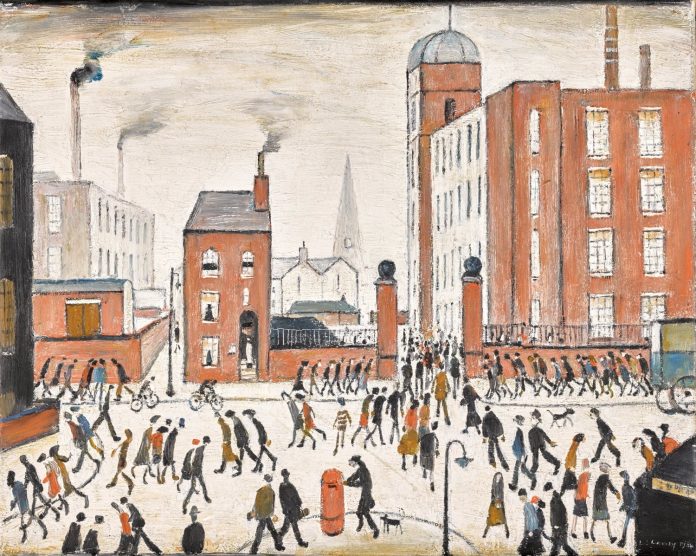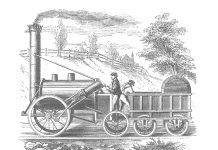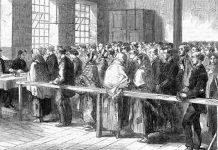One of the great painters of modern life, Lowry’s paintings capture life in the cities of the Industrial North of England and find beauty in the harsh reality. He possessed an extraordinary ability to combine acute observation, skilful composition and a real understanding of the lives lived in the streets, houses and factories that populate his most well-known works.
In 1909 Lowry moved to Pendlebury, and lived there for almost 40 years. His working method was to take sketches on the spot as he walked around the city in his capacity as a rent collector, and his scenes are populated with the characters he would have encountered and saved in his visual memory. Sotheby’s Modern & Post-War British Art Sale on 21 November will celebrate Britain’s best-loved artist with a selection of outstanding paintings. Full catalogue available online here.
Laurence Stephen Lowry, The Rush Hour, oil on canvas, 1964 (est. £800,000-1,200,000)
‘…as I got to the top of the station steps, I saw the Acme Spinning Company’s Mill, the huge black framework of rows of yellow-lit windows stood up against the sad, damp-charged afternoon sky. The mill was turning out hundreds of little pinched, black figures, heads bent down… I watched this scene – which I’d looked at many times without seeing – with rapture.’ – L.S. Lowry
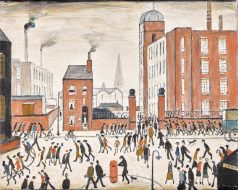 Appearing at auction for the first time, this iconic example of Lowry’s carefully crafted compositions centres on a towering building thought to be the Acme Spinning Company Mill in his hometown – the sight of which first inspired his interest in industrial scenes. A carefully crafted work, the result of decades of observation, The Rush Hour displays Lowry’s technical skill in compositional arrangement – with factory buildings and chimneys in the background framing the city’s inhabitants rushing to and from work. The classic Lowry motifs are all present: factories with chimneys billowing smoke, a distant spire, terraced houses, railings, walled alleyways, lampposts and the mill with its large gate. Among this static set of industrial scenery, Lowry introduces his cast of characters who create the movement and rhythm – reflecting his interest in ‘the flow of people’ and infusing the composition with a busy energy to be found in every city centre.
Appearing at auction for the first time, this iconic example of Lowry’s carefully crafted compositions centres on a towering building thought to be the Acme Spinning Company Mill in his hometown – the sight of which first inspired his interest in industrial scenes. A carefully crafted work, the result of decades of observation, The Rush Hour displays Lowry’s technical skill in compositional arrangement – with factory buildings and chimneys in the background framing the city’s inhabitants rushing to and from work. The classic Lowry motifs are all present: factories with chimneys billowing smoke, a distant spire, terraced houses, railings, walled alleyways, lampposts and the mill with its large gate. Among this static set of industrial scenery, Lowry introduces his cast of characters who create the movement and rhythm – reflecting his interest in ‘the flow of people’ and infusing the composition with a busy energy to be found in every city centre.
‘A street is not a street without people’ – L.S. Lowry
Lowry’s paintings were a profound exploration of the human condition and in this inner city rush no two figures are the same. The artist was fascinated by the physiology of groups and crowds – which he called ‘the most lonely thing of all’. City dwellers are delicately arranged and with a few flicks of the brush the artist manages to impart their cares and burdens in the bend of their legs or the curve of their backs. Interestingly, Lowry’s stoic working class figures go to work, leave work or are out of work, but are never depicted inside the mills, factories and mines.
Laurence Stephen Lowry, The Steps, oil on canvas, 1962 (est. £650,000-850,000)
 Steps were a common motif within Lowry’s paintings, favoured by him perhaps because they enabled such an easily identifiable sense of movement. This painting cleverly focuses on the architectural balance between the pyramid of steps in the foreground with a steep incline, drawing the viewer’s eye up to the terrace of houses on the horizon. The scene is brimming with activity with a Sunday sort-of-feel, as figures go about their daily lives oblivious to the fact that they are being immortalised in paint. The exception to this is a curious male figure in the centre foreground, to whom the viewer’s eyes are immediately drawn with his bright red bow tie – possibly intended as a quiet self-portrait of the artist himself.
Steps were a common motif within Lowry’s paintings, favoured by him perhaps because they enabled such an easily identifiable sense of movement. This painting cleverly focuses on the architectural balance between the pyramid of steps in the foreground with a steep incline, drawing the viewer’s eye up to the terrace of houses on the horizon. The scene is brimming with activity with a Sunday sort-of-feel, as figures go about their daily lives oblivious to the fact that they are being immortalised in paint. The exception to this is a curious male figure in the centre foreground, to whom the viewer’s eyes are immediately drawn with his bright red bow tie – possibly intended as a quiet self-portrait of the artist himself.
Laurence Stephen Lowry, The Ferry at Blyth, oil on canvas, 1963 (est. £600,000-800,000)
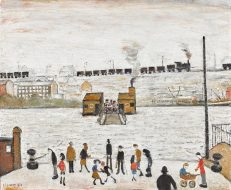 The genius of Lowry lay in his unique role as an observer of the strange, dislocating sights the city throws up at every corner. The Ferry at Blyth depicts a ‘chain ferry’ traversing a narrow strip of cold, dirty water’. A specific, functioning part of the urban landscape, this is a distinctly urban feature, with no romantic allusions to the freedom of the open seas. Yet in Lowry’s hands, the everyday mode of transport is lent an almost surreal quality as he depicts it as a ‘double-take’ – as if one of his trademark terraced houses has suddenly found itself afloat. The painting is also a poignant symbol of the way things were, epitomised by the visual pun made between the smoke of the ferry and the passing goods train behind.
The genius of Lowry lay in his unique role as an observer of the strange, dislocating sights the city throws up at every corner. The Ferry at Blyth depicts a ‘chain ferry’ traversing a narrow strip of cold, dirty water’. A specific, functioning part of the urban landscape, this is a distinctly urban feature, with no romantic allusions to the freedom of the open seas. Yet in Lowry’s hands, the everyday mode of transport is lent an almost surreal quality as he depicts it as a ‘double-take’ – as if one of his trademark terraced houses has suddenly found itself afloat. The painting is also a poignant symbol of the way things were, epitomised by the visual pun made between the smoke of the ferry and the passing goods train behind.

